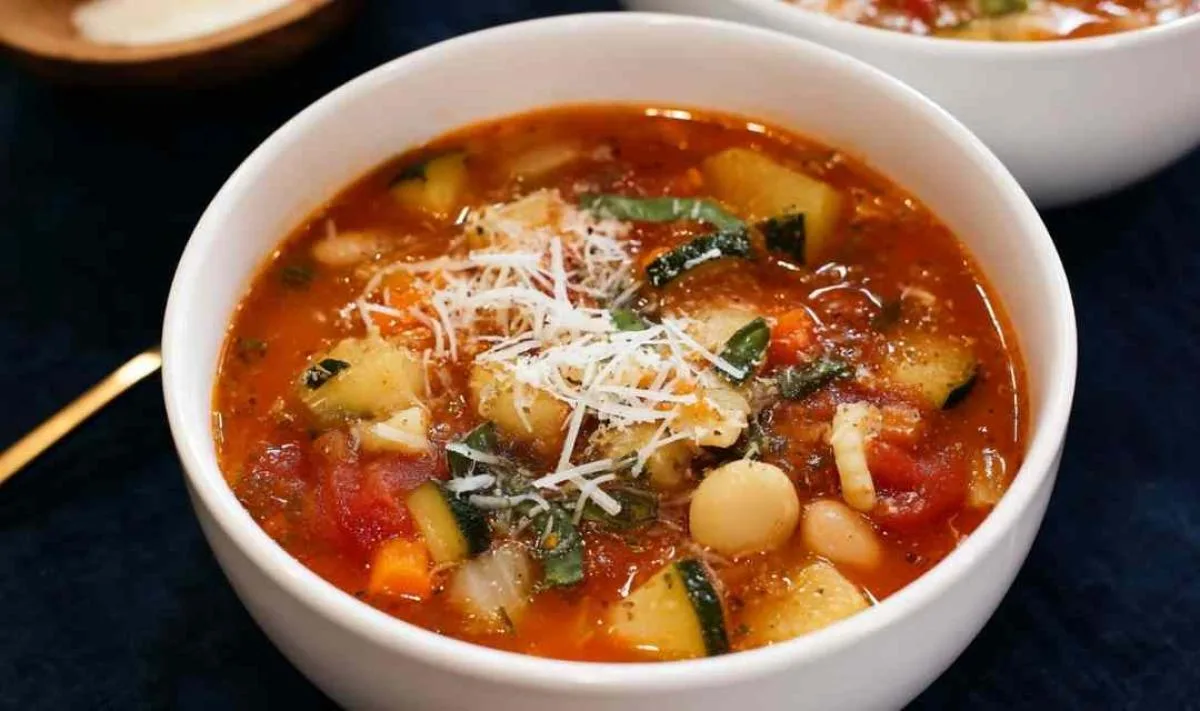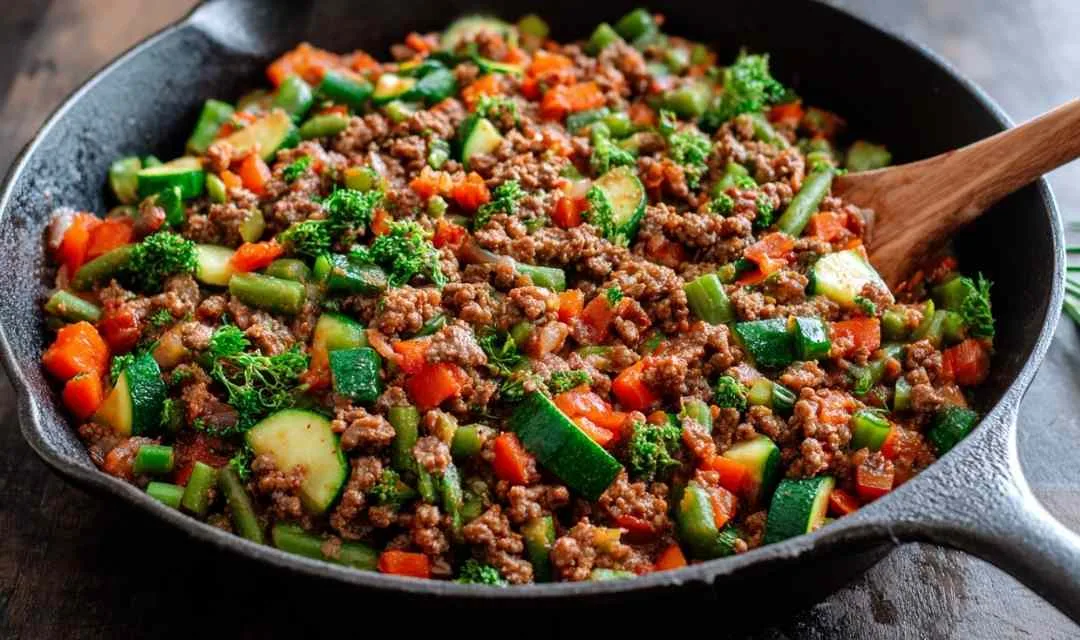Classic minestrone soup is the kind of dish that reminds me why I fell in love with cooking in the first place. It’s honest, nourishing, and absolutely bursting with flavor. There’s something magical about watching all those fresh vegetables transform into something warm, comforting, and deeply satisfying in just over an hour.
I still remember my grandmother standing at her kitchen stove on Sunday afternoons, the whole farmhouse filling with the aroma of simmering tomatoes, fragrant herbs, and garden-fresh vegetables coming together in perfect harmony. That’s when I learned that real cooking isn’t complicated. It’s about starting with quality ingredients, respecting each one’s role, and letting them do what they do best.
Growing up in the Midwest, we didn’t have fancy restaurants on every corner, but we had something better: a kitchen filled with love and recipes that had been passed down through generations. My grandmother’s minestrone was one of those recipes. It appeared on our table regularly, especially when the weather turned cooler and we all craved something warm and substantial.
She taught me that the secret wasn’t some exotic ingredient or complicated technique. It was patience, good olive oil, and knowing when to taste and adjust the seasonings. Now, as I make this classic minestrone soup for my own family, I’m watching my grandchildren ask for seconds, and I know these recipes will live on. Time to get our hands busy and fill your kitchen with that incredible minestrone aroma.
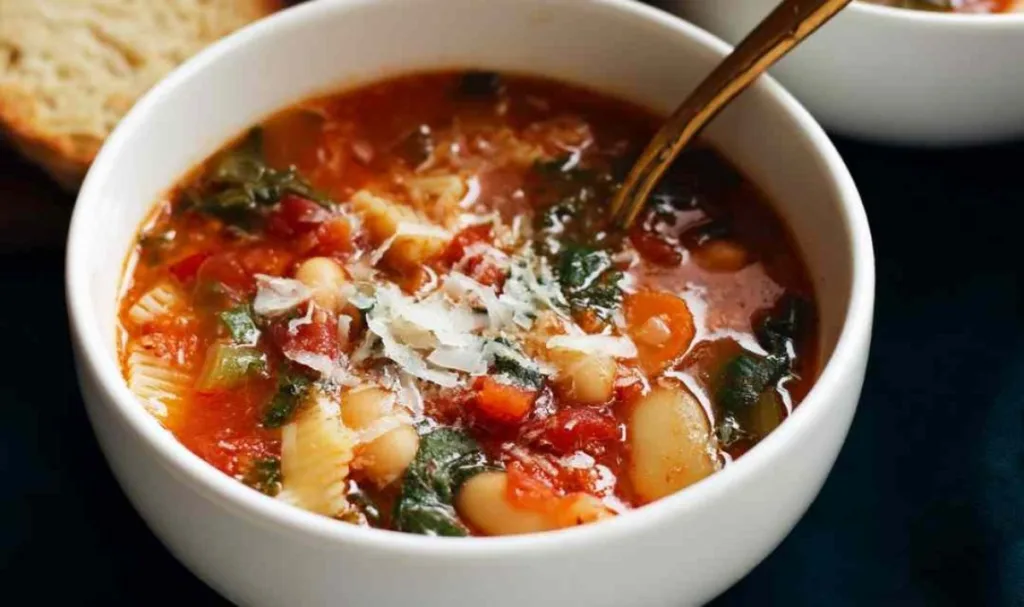
What Makes This Classic Minestrone Soup So Special
This minestrone soup recipe has everything that makes for a truly memorable meal. I’ve been making versions of this for decades now, and I’ve learned exactly what makes it shine on the table. It’s the kind of soup that feels like a warm hug in a bowl. Hearty enough to satisfy, yet light enough that you never feel weighed down afterward.
- Uses pantry staples you likely already have. Between canned tomatoes, beans, pasta, and fresh vegetables from your garden or farmers market, you probably have everything on hand right now.
- Comes together in just over an hour on busy weeknights. This is my go-to dinner that doesn’t require constant supervision or complicated timing.
- Delivers that crowd-pleasing comfort everyone craves. Children and adults alike ask for seconds, making it perfect for family gatherings and busy weeknight dinners.
- Adapts easily to what’s in your kitchen. Seasonal vegetables mean you can make it year-round with whatever produce looks best at the market.
- Works beautifully for both vegetarians and vegans. Skip the Parmesan garnish and you have a naturally vegan soup that doesn’t feel like you’re missing anything.
- Creates those perfect contrasts of texture and flavor. Tender vegetables, al dente pasta, creamy beans, and bright herbs all working together in perfect balance.
After years of making this recipe and feeding hundreds of people, I can tell you that this minestrone soup is reliable, adaptable, and absolutely delicious every single time.
Ingredient Spotlight: What Goes Into This Recipe
I’ve learned that understanding your ingredients is half the battle when it comes to creating great minestrone soup. Each player in this recipe has an important role, and I always choose quality versions because they truly make a difference in the final dish.
Extra-virgin olive oil – I always choose a good-quality extra-virgin olive oil for this recipe. It’s the foundation of the flavors, and using the best you can afford makes a noticeable difference in how rich and satisfying your minestrone tastes.
Yellow onion, carrots, and celery – These three form what I call the vegetable foundation of nearly every excellent soup I’ve ever made. They create a flavorful base that everything else builds upon, adding sweetness and depth that makes the broth taste like it’s been simmering for hours.
Tomato paste – In my kitchen, I prefer tomato paste because it concentrates all that rich tomato flavor into one powerful ingredient. A quarter cup adds incredible depth without requiring a huge can of tomatoes.
Seasonal vegetables – This is where you get creative and use what’s best at your market. Potatoes add substance, zucchini and summer squash bring freshness, green beans add texture, and peas make everything taste like comfort. I typically choose whatever vegetables look most vibrant and fresh.
Garlic – After years of making soups, I learned that fresh garlic pressed or minced right into the pot creates so much more flavor than jarred. Four cloves is my sweet spot for this pot. Enough to be noticeable without overpowering the other flavors.
Dried oregano and thyme – These Mediterranean herbs are what transform a simple vegetable soup into authentic Italian minestrone. I’ve found that dried herbs work beautifully here, releasing their flavors gradually as the soup simmers.
Diced tomatoes – One large can of good quality diced tomatoes gives you that bright, tomato-forward flavor that makes this minestrone recognizable. I always use tomatoes with their liquid because that juice adds flavor.
Vegetable broth and water – I recommend using good vegetable broth as your base. The combination of broth and water gives you enough liquid without making the soup taste too intense or one-dimensional.
Great Northern or cannellini beans – These mild white beans absorb the flavors of the broth beautifully and add protein and substance to make this a truly filling meal. I typically rinse canned beans well before adding them.
Pasta – Whole grain orecchiette, elbow pasta, or small shells are my favorites. I choose pasta shapes that won’t get lost in the soup and that cook relatively quickly. The pasta should be cooked until just al dente so it doesn’t turn mushy as the soup sits.
Fresh greens – Baby spinach, kale, or collard greens add nutrition and a fresh brightness that balances the richness of the other ingredients. I always add these near the end so they stay vibrant and tender.
Lemon juice – This final squeeze of brightness is what I’ve learned makes minestrone soup really sing. It brings all the flavors into focus and adds a subtle lift that makes people ask what your secret ingredient is.
How to Make Classic Minestrone Soup: Step by Step
I’ve perfected this technique over many years of making minestrone, and I’m sharing Betty’s tested approach that delivers consistent, delicious results every time.
Step 1: Warm 3 tablespoons of the olive oil in a large Dutch oven or stockpot over medium heat. Once the oil is shimmering, add the chopped onion, carrot, celery, tomato paste, and a pinch of salt. Cook, stirring often, until the vegetables have softened and the onions are turning translucent, about 7 to 10 minutes. I’ve found that this foundation step is absolutely crucial. Don’t rush it, because this is where the flavor of your entire minestrone soup begins to develop.
Step 2: Add the seasonal vegetables, garlic, oregano, and thyme. Cook until fragrant while stirring frequently, about 2 minutes. Through trial and error, I learned that this brief cooking time releases the essential oils from the herbs and helps the garlic become part of the flavor base rather than just floating on top.
Step 3: Pour in the diced tomatoes and their juices, broth, and water. Add the salt, bay leaves, and red pepper flakes. Season generously with freshly ground black pepper. Betty always starts by tasting at this point to see if the seasoning feels balanced.
Step 4: Raise heat to medium-high and bring the mixture to a boil, then partially cover the pot with the lid, leaving about a 1-inch gap for steam to escape. Reduce heat as necessary to maintain a gentle simmer. After years of making this, I’ve learned that the gentle simmer creates the best flavor. Rapid boiling actually diminishes the taste of minestrone soup.
Step 5: Cook for 15 minutes while covered. I’ve found that this initial simmering time allows the vegetables to become completely tender and all those flavors to really marry together beautifully.
Step 6: Remove the lid and add the pasta, beans, and greens. Continue simmering, uncovered, for 20 minutes or until the pasta is cooked al dente and the greens are tender. The key I discovered is that uncovered simmering prevents the pasta from becoming too mushy and allows the broth to reduce slightly, concentrating the flavors even more.
Step 7: Remove the pot from the heat and carefully remove the bay leaves. This is easy to forget but important for the final presentation. Stir in the lemon juice and the remaining tablespoon of olive oil. This final touch is what makes your minestrone soup taste like it came straight from a farmhouse kitchen.
Step 8: Taste and season with more salt (I usually add about 1/4 teaspoon more) and pepper until the flavors really sing. My family prefers when I taste and adjust at this point rather than earlier, because now you can hear all the flavors clearly. Divide into bowls and garnish with freshly grated Parmesan cheese if you’d like. Though this soup is equally delicious without it.
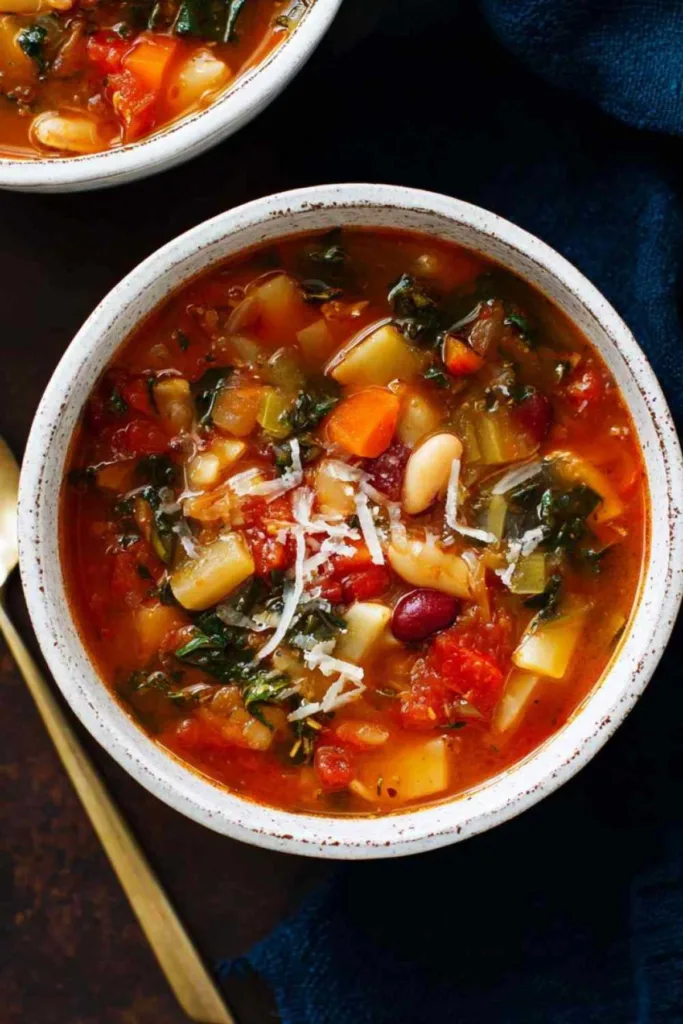
Keeping This Classic Minestrone Soup Fresh: Storage and Reheating
I want you to feel confident that your minestrone soup will taste just as good on day three as it does fresh off the stove. Over the years, I’ve developed storage methods that keep both the flavor and texture exactly where they should be.
Refrigerator Storage: I typically store leftovers in an airtight glass container in the refrigerator, where the minestrone soup will stay fresh for 4 to 5 days. The flavors actually improve over the first day or two as all those vegetable and herb flavors continue to meld together. Just keep in mind that the pasta will continue absorbing broth, so if you find it getting too thick, simply add a splash of broth or water when reheating.
Freezing Your Minestrone Soup: Betty’s freezing method works well because I freeze the soup in individual portions in freezer-safe containers or even in ice cube trays for smaller quantities. The minestrone soup freezes beautifully for up to 3 months, which means you always have homemade comfort food ready when you need it. I’ve found that freezing in smaller portions makes reheating much easier and helps preserve quality. Pro tip: Leave a little space at the top of containers before freezing, as the liquid will expand slightly.
Reheating for Best Results: For the best texture, I reheat minestrone soup on the stovetop over medium heat, stirring occasionally, until it reaches a gentle simmer. This takes about 10 to 15 minutes depending on the portion size, and it allows the flavors to warm through evenly without any hot spots. If the soup seems too thick after freezing, simply add vegetable broth or water until it reaches your preferred consistency. Avoid the microwave if possible. The stovetop method really does create the best results and only takes a few extra minutes.
Perfect Partners for Classic Minestrone Soup: Complete Your Meal
This hearty minestrone soup truly shines when paired with the right sides. I’ve learned what works best for making a complete, satisfying meal that leaves everyone at the table happy.
- Crusty bread – A thick slice of toasted bread brushed with extra-virgin olive oil is perfect for soaking up every last drop of that incredible broth.
- Fresh basil – A handful of fresh basil leaves torn over the top right before serving adds brightness and a subtle sweetness that complements the Italian flavors perfectly.
- Simple green salad – The freshness of crisp greens and a light vinaigrette balances the warmth and substance of the minestrone beautifully. Try a fresh Mediterranean Lentil Soup alongside for even more flavor variety.
- Garlic bread – My family’s favorite accompaniment is homemade garlic bread, and the combination never fails to make everyone ask for seconds.
- Extra virgin olive oil drizzle – A final swirl of your best olive oil over each bowl adds richness and elegance that makes a simple soup feel special.
- Freshly grated Parmesan cheese – Just a small handful of quality Parmesan transforms each spoonful, though the soup is wonderful without it if you’re keeping things vegan.
For a heartier meal, you might also enjoy pairing this with Easy Minestrone Soup variations or serving it as part of a soup sampler with Authentic Italian Lentil Soup.
FAQs About Classic Minestrone Soup
Can I make this minestrone soup without pasta? Absolutely. I recommend this to people who are watching their carbohydrates or just prefer a brothier soup. You’ll have just as much of a meal thanks to the beans and vegetables providing substance and nutrition.
What’s the best way to substitute vegetables in minestrone soup? I always choose whatever vegetables look freshest and most vibrant at your market. Potatoes, zucchini, yellow squash, butternut squash, green beans, peas, bell peppers, or even mushrooms all work beautifully. The key is cutting everything to roughly the same size so it cooks evenly.
Can I make this minestrone soup ahead of time? Yes. In fact, many home cooks find success making minestrone soup the day before serving. The flavors actually become even more integrated and delicious after sitting overnight in the refrigerator.
Is this minestrone soup freezer-friendly? Betty’s solution is that the soup freezes beautifully for up to 3 months. I recommend freezing in portion-sized containers so you always have homemade comfort food ready for quick meals.
How do I prevent the pasta from getting mushy in minestrone soup? To prevent this issue, I add the pasta during the final 20 minutes of cooking and cook it only until al dente. If you’re planning to refrigerate leftovers, the pasta will continue absorbing broth, which is why I sometimes add a little extra broth when reheating.
Can I make this recipe with homemade vegetable broth? The best approach I’ve tested is using homemade broth if you have it. It creates an even more flavorful minestrone. Store-bought broth works wonderfully too, so use whatever you have available.
Is this minestrone soup truly vegan? Yes. Simply skip the Parmesan cheese garnish and this becomes a naturally vegan minestrone soup. Everything else in the recipe is plant-based, making it a wonderful option for all your guests.
Can I use frozen vegetables instead of fresh? Absolutely. Frozen vegetables work beautifully in minestrone soup. I often use a frozen vegetable blend that includes carrots, celery, and onions as my base. Add them at the same time as you would fresh vegetables.
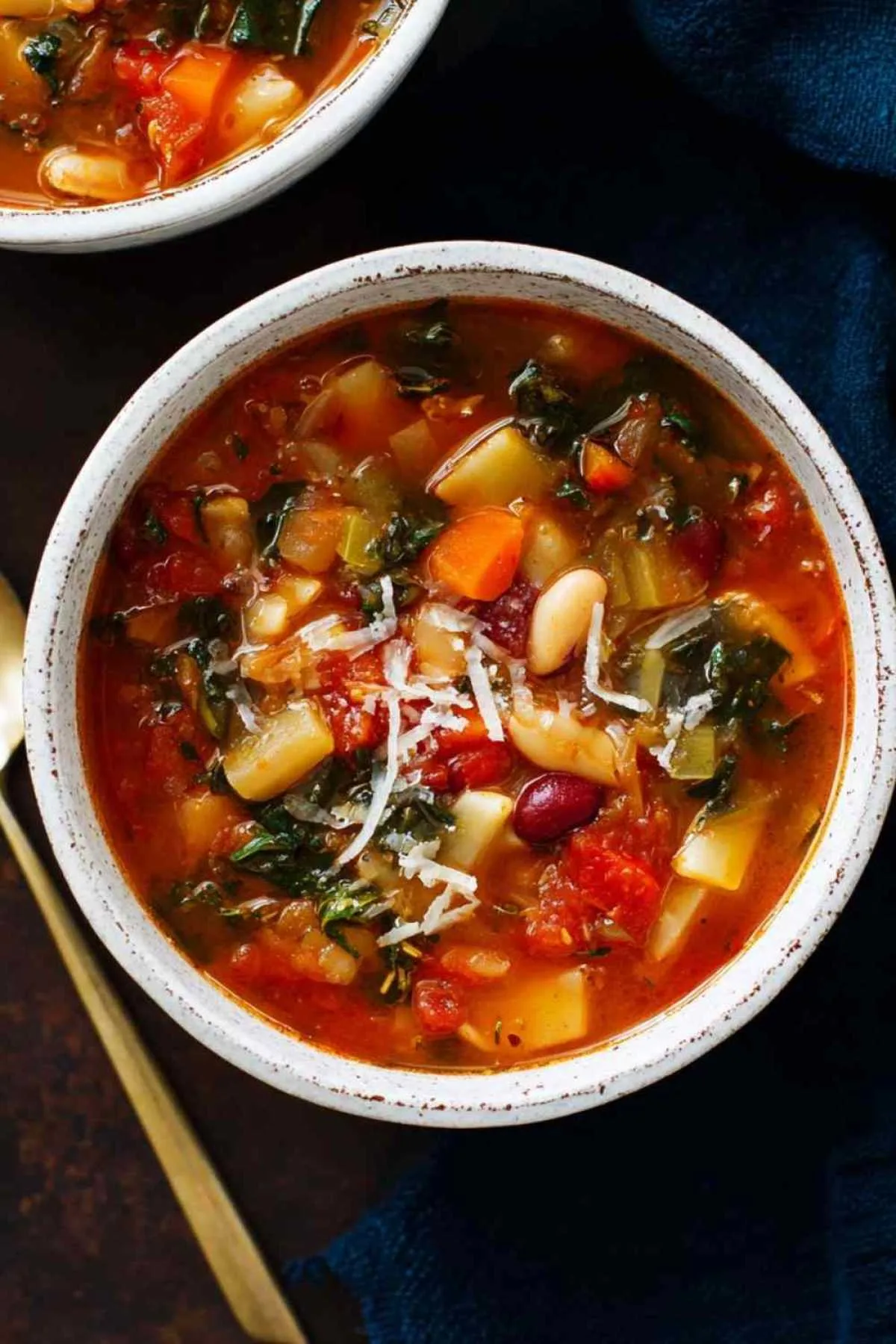
Classic Minestrone Soup
Ingredients
Equipment
Method
- Warm 3 tablespoons of the olive oil in a large Dutch oven or stockpot over medium heat. Once shimmering, add the onion, carrot, celery, tomato paste, and a pinch of salt. Cook, stirring often, until vegetables have softened and onions are translucent, about 7 to 10 minutes.
- Add seasonal vegetables, garlic, oregano, and thyme. Cook until fragrant, stirring frequently, about 2 minutes.
- Pour in diced tomatoes with their juices, broth, and water. Add salt, bay leaves, and red pepper flakes. Season generously with freshly ground black pepper.
- Raise heat to medium-high and bring to a boil. Partially cover the pot with a lid, leaving about a 1-inch gap for steam to escape. Reduce heat to maintain a gentle simmer.
- Cook for 15 minutes covered.
- Remove the lid and add the pasta, beans, and greens. Continue simmering uncovered for 20 minutes or until pasta is al dente and greens are tender.
- Remove from heat and remove bay leaves. Stir in lemon juice and remaining tablespoon of olive oil.
- Taste and season with additional salt and pepper until flavors are balanced. Garnish bowls with grated Parmesan if desired.
